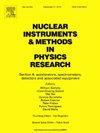基于Ricean分布拟合的亚毫米尺度位置敏感LG-SiPMs的空间分辨率和线性度定量测定
IF 1.4
3区 物理与天体物理
Q3 INSTRUMENTS & INSTRUMENTATION
Nuclear Instruments & Methods in Physics Research Section A-accelerators Spectrometers Detectors and Associated Equipment
Pub Date : 2025-06-28
DOI:10.1016/j.nima.2025.170774
引用次数: 0
摘要
位置敏感sipm在所有需要少量读出通道的光检测应用中都很有用,同时保留有关入射光的相互作用位置的信息。专注于一个2 × 2的LG-SiPMs阵列,覆盖面积为~ 15.5×15.5mm2,只有6个读出通道,我们提出了一种定量的方法来评估图像重建性能。该方法基于统计方法来评估设备在重建光斑重心时的精度(空间分辨率)和精度(线性度)。这种评价是通过Rice概率分布函数拟合实现的。我们获得的传感器空间平均分辨率为81±3μm(标准差),相应的精度为231±4μm。本文章由计算机程序翻译,如有差异,请以英文原文为准。
Quantitative determination of spatial resolution and linearity of position-sensitive LG-SiPMs at sub-millimeter scale via Ricean distribution fitting
Position-sensitive SiPMs are useful in all light detection applications requiring a small number of readout channels while preserving the information about the incoming light’s interaction position. Focusing on a 2 × 2 array of LG-SiPMs covering an area of with just 6 readout channels, we proposed a quantitative method to evaluate the image reconstruction performance. The method is based on a statistical approach to assess the device’s precision (spatial resolution) and accuracy (linearity) in reconstructing the light spot center of gravity. This evaluation is achieved through a Rice probability distribution function fitting. We obtained an average sensor spatial resolution of (standard deviation) with a corresponding accuracy of .
求助全文
通过发布文献求助,成功后即可免费获取论文全文。
去求助
来源期刊
CiteScore
3.20
自引率
21.40%
发文量
787
审稿时长
1 months
期刊介绍:
Section A of Nuclear Instruments and Methods in Physics Research publishes papers on design, manufacturing and performance of scientific instruments with an emphasis on large scale facilities. This includes the development of particle accelerators, ion sources, beam transport systems and target arrangements as well as the use of secondary phenomena such as synchrotron radiation and free electron lasers. It also includes all types of instrumentation for the detection and spectrometry of radiations from high energy processes and nuclear decays, as well as instrumentation for experiments at nuclear reactors. Specialized electronics for nuclear and other types of spectrometry as well as computerization of measurements and control systems in this area also find their place in the A section.
Theoretical as well as experimental papers are accepted.

 求助内容:
求助内容: 应助结果提醒方式:
应助结果提醒方式:


